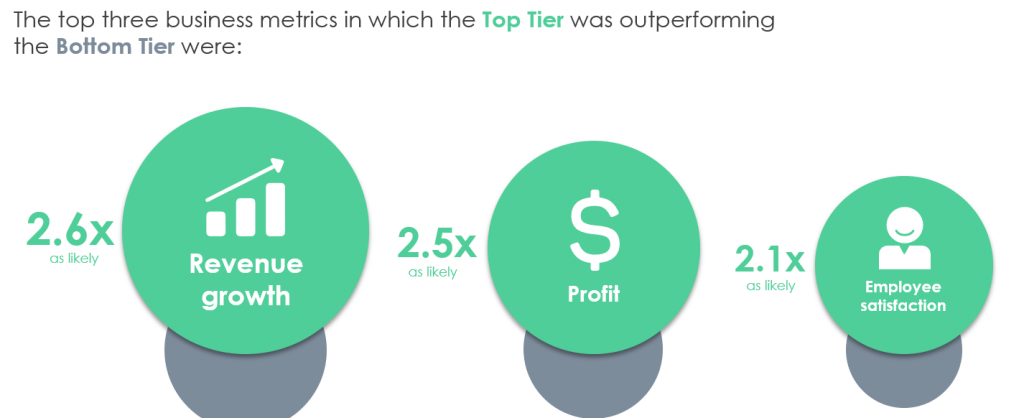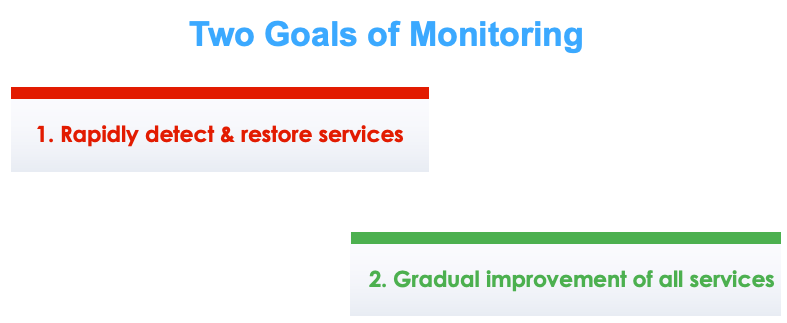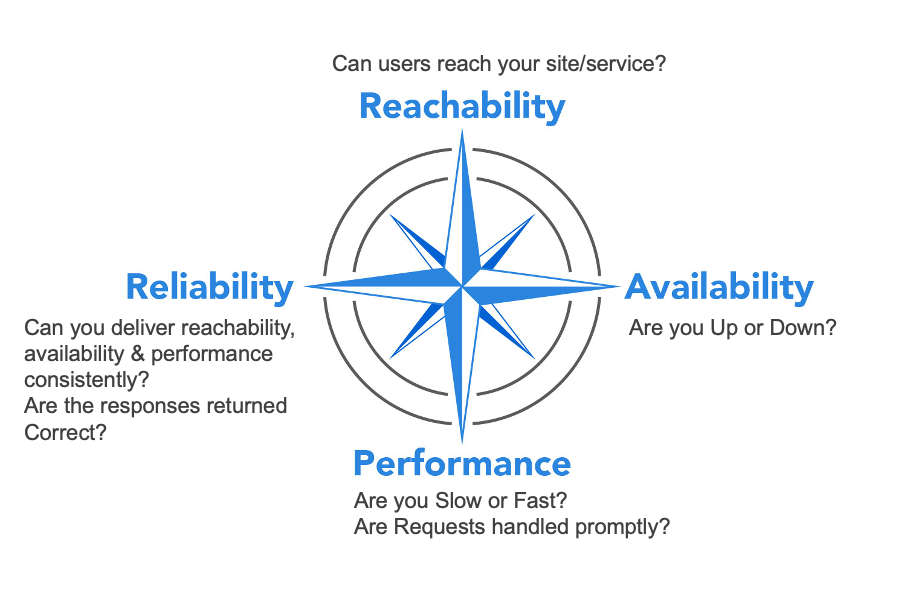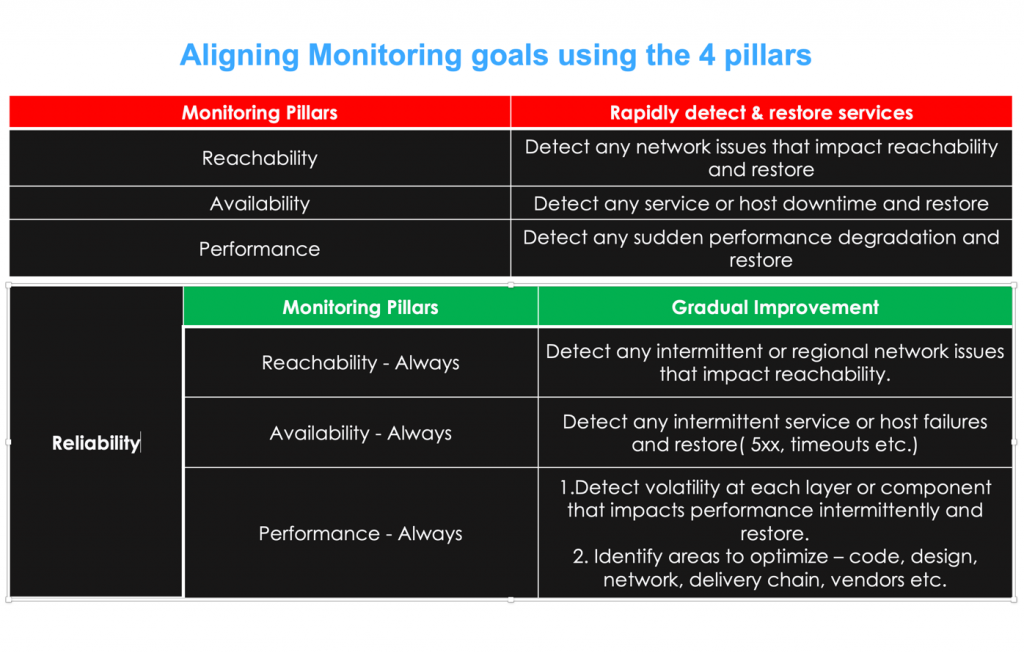One Company, Multiple Monitoring Mindsets
The mindset of IT stakeholders in an organization defines the monitoring approach and how it is prioritized.
Monitoring plays a critical part in the success of any business that relies on its digital services. Businesses want to understand true end-user experience – what enables or hinders a good end-user experience, and how it relates to their business goals. It plays a crucial role in answering some critical questions. Interestingly, our recent 2020 CIO Survey results highlight how the monitoring approach adopted by top/bottom tier organizations impact the overall business metrics.


The business models and verticals may be different across the industry but the use cases for monitoring are more or less similar for any organization. Yet, we see completely different monitoring mindsets within an organization. Developers use monitoring to understand if the new release works as expected and the impact on user experience etc. On the other hand, network/operations need monitoring to ensure the infrastructure and the network is working as expected.
At Catchpoint, I have worked with 400+ customers from different industry verticals, from across the world and something I have observed again and again is how one can easily guess the mindset of the strongest stakeholder in any organization just by looking at their monitoring technology stack and practices. Let me relate some real examples of this.
Too Many Monitoring Tools
One of the largest online travel shopping companies uses 20+ monitoring products across the company which is a very distributed organization. Each product line or team gets to choose a monitoring tool of their choice. The majority of these are either APM or Log analysis solutions. When we started discussing the challenges of the organization, some of the problems they described were:
- End users complain that the site is slow in some regions, but we don’t see any problem.
- Business teams demand answers as soon as there is a drop in revenue, but we don’t have an answer.
- They have a centralized incident response team but mostly focus on application availability issues alone.
The challengers existed despite the different monitoring tools available, clearly, the tools and the practice did not align with the needs and challenges of the organization.
Monitoring Strategy with Blinders
Another example is that of a major financial services company in the US. The company was struggling with performance issues across all their call centers. Remote employees from across the globe were accessing applications hosted in their origin datacentre via VDI and they were using multiple MPLS, SDWAN, and WAN optimization services yet the employees were experiencing major challenges to get their work done. The issues were broadly categorized into slow connection, latency, and connection time outs.
They had multiple network monitoring tools monitoring both remote offices and their data center. They also had endpoint monitoring solutions in place. Yet none of these were able to connect the dots between the end-user challenges and the root cause.
They were looking for Synthetic network monitoring solution that provided network path visibility. Basically, another network tool on top of the existing network tools. It is obvious the stakeholders leading the efforts to solve this problem are from the network/Operations background.
Holistic Monitoring Strategies
An eCommerce company, one of the largest in the world, was focusing on optimizing their application performance globally. They were using five different CDNs, 25+ own edge POPs, four major data centers, microservices, containers, distributed teams, etc. They have a centralized monitoring team using one APM solution, Catchpoint Synthetics monitoring for all their critical endpoints and user journey, and using a SIEM to pull all data and logs to a single place with intelligence built on top of this.
The goals were clearly defined, visibility into every layer using a combination of logs, APM, and synthetics so they can quickly detect anything as soon as it breaks. They were also actively looking at historical performance and different datasets and statistics to identify optimization areas in each layer. Their optimization efforts included the code, the front end, the delivery chain, the cloud providers, vendors, etc. This holistic and neutral mindset has ensured a great end-user experience with a continuous focus on optimizing the user experience while delivering business results.
Different Mindsets, Different Strategies
The mindset of IT stakeholders in an organization defines the monitoring approach and how it is prioritized. The monitoring mindsets of organizations can fall under one of the following categories:
- Infrastructure First
- Network First
- Application First
- End User First
- Business Results First
While it is true that these are different siloed entities within an organization, with their own responsibilities, priorities, and some shared goals, the success of each of these teams is crucial for the success of the entire organization. But often, what technologies and practices are chosen by the organization usually depends on the mindset of the strongest stakeholder at the table. And that can sometimes be dangerous for the entire company.
For example, if the strongest stakeholder is from a developer/engineering background, then their implicit beliefs would push them towards an “Application First” monitoring mindset, resulting in more investments into Application monitoring solutions and methodologies.
Similarly, if the strongest stakeholder is from an operations background, then their implicit beliefs would push them towards an “Operations/Infrastructure First” monitoring mindset, resulting in more investments into Infrastructure monitoring solutions and methodologies.
There are several advantages and best practices in each of these monitoring mindsets and the organization’s success is defined in their own ways.
However, the only challenge that the organizations fail to realize or are often forced to adjust much later, is how disconnected they are when it comes to aligning themselves with the big picture. i.e. aligning themselves with their end users who determine the business results.
Most large organizations have two types of monitoring team structures:
- Centralized Monitoring Teams
- Decentralized Monitoring Teams – where each product or service team has the freedom to get their own monitoring tools and methodologies.
While the mindset challenge is faced by all types of organizations, things can get messy in organizations that have a decentralized structure. In the case of centralized monitoring teams, the realization of the gaps and alignment happen a little faster. However, the real and deeper challenge is with organizations that have a decentralized structure. Here there are:
- Many mindsets
- Many approaches
- Many tools
- Many methodologies
- Many best practices
- But one common goal
The other factors that add to the complications:
- The technological evolutions – Cloud Computing, Multi-Cloud, Hybrid Cloud, Edge Computing, Network, 5G Everything as a service.
- The methodology evolutions – DevOps, DevSecOps, CICD, Continuous everything, SRE, Observability, containers, microservices, serverless computing.
- The biased evangelists – The vendors who claim that their methodology is the best and right approach.
The matrix just gets more and more complicated. This is where some guiding principles and philosophy plays a crucial role in guiding organizations.
- Fixed and Narrow Mindset
- Growth and Open Mindset
This is not just important for Business and Technological innovations but for the monitoring organizations too.
In a Fixed Mindset, stakeholders believe in their fixed implicit beliefs and therefore stick to it. They do not adapt to the changes and evolutions discussed above. Some examples of fixed mindset monitoring organizations:
- Our priority is to ensure we are meeting our internal SLAs we have committed to the business.
- Our priority is to ensure the application is working
- Our priority is to ensure we release features seamlessly.
- We have established a performance baseline and we want to ensure we stay under it.
In the Growth Mindset, stakeholders align themselves with the changes in the business, the technological trends, the expectations of the end users, and are constantly learning. They have an underlying belief that continuous learning and adjustment is crucial for continuous growth. Some examples of growth mindset monitoring organizations:
- Our priority is to ensure we deliver business results
- Our priority is to ensure delivery of the best end-user experience.
- Our priority is to ensure we identify areas we can optimize end-user experience that can help optimize business results.
- We have initiatives to constantly improve. Shift left and shift right.
- We want to hold each of our vendors accountable by measuring them and challenge them to do better.
- Our mission is to deliver good experience consistently to all our end users from all around the world.
- We want to be proactive, anticipate bottleneck and points of failure and have back up plans.
Irrespective of which monitoring methodology or solution an organization chooses to use they should consider these two key factors under the growth mindset:
- Two goals of monitoring
- The four monitoring pillars
Two Goals of Monitoring
The monitoring solutions that monitor any application, service, network, infrastructure components should not only be able to help detect an incident or disruption but should also be able to help identify potential optimization areas:

The Four Monitoring Pillars
Just like the four golden signals of the SRE practice recommended by Google, we at Catchpoint recommend these four pillars of monitoring.

These four pillars are a great approach to help accomplish the monitoring goals:

What the monitoring world today needs is the Growth Mindset! The growth mindset will help align the priority of the five monitoring mindsets mentioned above and in turn, help organizations to not just achieve but exceed their business goals.
I will conclude this article with a popular anonymous quote:
“Whatever you hold in your mind will tend to occur in your life. If you continue to believe as you have always believed, you will continue to act as you have always acted. If you continue to act as you have always acted, you will continue to get what you have always gotten. If you want different results in your life or your work, all you have to do is change your mind”


